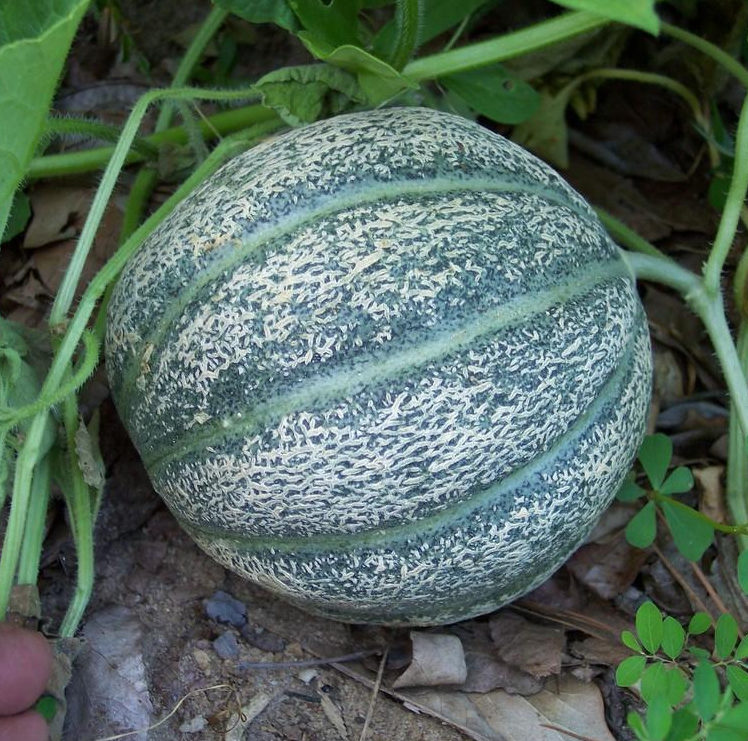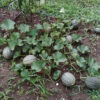Description
Hearts of Gold Cantaloupe (a.k.a. Hoodoo)
25 Seeds per pack
Days to Maturity: 80–90 days
Sun Requirements: Full Sun
Botanical Name: (Cucumis melo)
Hearts of Gold is a old time heirloom cantaloupe known for its rich flavor, deep orange flesh, and juicy flesh. First released around 1895 by Roland Morrill of Benton Harbor, Michigan, this variety quickly became a favorite across the Midwest and later found fame in Fallon, Nevada, where it fueled a local melon boom and inspired a festival that still draws crowds today.
The melons are nearly round, medium-sized growing 2–4 pounds, and wrapped in a heavily netted, medium-ribbed rind with a thin skin and small seed cavity. Inside, the firm, juicy flesh is fragrant and exceptionally sweet—one of the most flavorful among heirloom types. When ripe, the skin turns a warm beige between the netting.
Plants grow as vigorous, sprawling vines reaching 6–10 feet in length and 12–18″ tall. They’re known for high yields, rust and blight resistance. Whether sliced fresh, served in desserts, Hearts of Gold lives up to its name with every bite!
Disease Resistance: Rust and blight
Planting Instructions for Hearts of Gold Cantaloupe Seeds
When to Plant:
Direct sow Hearts of Gold Cantaloupe seeds outdoors 1 to 2 weeks after your last frost date, once the soil consistently reaches 70°F (21°C) or warmer. For shorter seasons or cooler regions, start seeds indoors 4 to 6 weeks before last frost, using peat pots or soil blocks to avoid root disturbance. Transplant outdoors after hardening off and when both soil and air temperatures are consistently warm and the danger of frost is past.
Where to Plant:
Choose a site in full sun that receives at least 8 hours of direct sunlight daily. Hearts of Gold Cantaloupes thrive in fertile, well-drained soil with a pH of 6.0–7.0. Raised beds or south-facing slopes are ideal. Incorporate 2–3 inches of compost before planting. Avoid planting in areas that recently grew other melons, cucumbers, squash, or pumpkins.
How to Sow:
Sow seeds ½” to 1″ deep. If planting in rows, space seeds or transplants 18–36″ apart in rows 5–6′ apart. For hills, sow 3–4 seeds per hill and thin to the strongest 1–2 plants. For trellising, space plants 12–18″ apart along a sturdy support.
Watering:
Keep soil consistently moist through germination. Once vines are established, provide 1–2 inches of water per week. Water deeply and less frequently to encourage deep rooting. Reduce watering slightly once fruit begins to ripen to improve sweetness and avoid splitting. Avoid overhead watering to reduce the risk of mildew.
Fertilization:
Mix compost into the planting site before sowing. Additional fertilizer is typically not needed unless soil is poor. If desired, side-dress with compost tea, fish emulsion, or a balanced organic fertilizer once vines begin to spread and again when the first small fruits begin to form.
Mulching:
Once your seedlings are growing well, add mulch around the plants. Use black plastic if your goal is to warm the soil. Warmer soil helps seeds sprout faster and encourages early root and vine growth, which is especially helpful in cooler climates or early in the season. If you’re mainly trying to hold in moisture and stop weeds, straw or shredded leaves are good options, but they won’t help the soil warm up as much. Mulching also keeps the fruits clean by lifting them off the dirt and helps stop mud from splashing onto them when it rains.
Training & Pruning:
Vines can be allowed to sprawl or trained vertically. For vertical growth, support fruit with cloth slings. If desired, lightly prune some of the small side branches that grow off the main vine to help air move through the plant and let it focus energy on growing better-quality fruits. Avoid over-pruning, which can reduce flower production and sugar development.
Pollination:
Hearts of Gold Cantaloupes produce both male and female flowers. Bees and other pollinators are essential for fruit set. Encourage pollination by planting pollinator-friendly flowers and herbs nearby. Good choices include borage, dill, sunflowers, marigolds, and oregano allowed to flower. These help attract bees and other insects that will visit your Hearts of Gold Cantaloupe blooms. In low-pollinator areas, hand pollinate by transferring pollen from male to female blooms using a small paintbrush.
Common Pests & Diseases:
- Pests: Watch for aphids, cucumber beetles (vector for bacterial wilt), squash bugs, and vine borers. Use row covers until flowering, hand-pick pests, or apply insecticidal soap in the early morning or evening.
- Diseases: Powdery mildew, downy mildew, and leaf blights can occur. Improve air circulation, avoid overhead watering, and space plants adequately. Treat outbreaks with organic fungicides or DIY sprays (e.g., baking soda solution).
Harvesting:
Hearts of Gold Cantaloupes are ready to harvest when the rind is deeply netted and the skin turns a warm beige between the netting. The fruit should slip easily from the vine with gentle pressure. The blossom end should give slightly when pressed, and the melon will give off a strong, sweet, musky aroma when fully ripe.
Storage:
Store ripe, uncut Hearts of Gold Cantaloupes at 45–50°F for up to 1 week. Once cut, refrigerate and use within 3 days. Wash melons thoroughly before cutting to avoid transferring bacteria from rind to flesh.
Seed Saving:
Saving Hearts of Gold Cantaloupe seeds is an enjoyable and economical way to preserve this classic heirloom variety. Hearts of Gold Cantaloupes are insect-pollinated and cross readily with other melon types, so avoid growing multiple melon varieties within ½ mile of one another.
Let the melons ripen fully on the vine. Once picked, cut them open the long way and scoop out the seeds into a jar. Add room temperature (not hot) water and let the mixture sit for 2 to 4 days, stirring it once each day to help the seeds separate. Good seeds will sink, while pulp and non-viable seeds float. Pour off the debris, rinse the good seeds thoroughly, and spread them out on a paper towel or mesh screen to dry for several days in a well-ventilated area.
Once your seeds are fully dry, you can store them in a labeled container. For longer storage, you can keep the container right in the freezer. Freezing helps protect seeds from moisture, pests, and temperature swings, especially over many months. For a quick and easy option, use our seed-saving envelopes. They’re simple to use, pre-labeled, and include spaces to write the variety, date, and any notes you want to remember. They help keep your seeds neat, labeled, and easy to find when you’re ready to plant next season. When stored properly, Hearts of Gold Cantaloupe seeds can last 3–5 years.
FAQ:
What is the historical or notable background of Hearts of Gold Cantaloupe?
Hearts of Gold was introduced around 1895 by Roland Morrill in Benton Harbor, Michigan. It gained widespread acclaim throughout the Midwest and famously became a cornerstone of Fallon, Nevada's agricultural scene—so much so that it inspired a melon festival that continues to draw crowds today!
How would you describe the flavor of Hearts of Gold Cantaloupe?
Hearts of Gold is celebrated for its exceptionally sweet, juicy, and fragrant flesh. Its deep orange interior delivers a rich and complex melon flavor that stands out, and is widely considered the the best taste heirloom melon!
What does the fruit look like, and how does it grow?
Hearts of Gold melons are nearly round and medium-sized, typically weighing between 2 to 4 pounds. They have a heavily netted rind with a warm beige color at ripeness and grow on sprawling vines that can reach 6–10 feet long and 12–18 inches tall.
How and when do I harvest Hearts of Gold Cantaloupe?
These melons are ready to harvest when the rind becomes deeply netted, the skin turns a beige tone between the netting, and the fruit slips easily from the vine with a gentle tug. A sweet, musky aroma and slight softness at the blossom end also signal peak ripeness.
When is the best time to plant Hearts of Gold Cantaloupe?
Plant outdoors 1–2 weeks after the last frost when soil temperatures stay above 70°F. In cooler climates, start seeds indoors 4–6 weeks before the last frost and transplant them once all danger of frost has passed.
What are common culinary uses for Hearts of Gold Cantaloupe?
Enjoy Hearts of Gold sliced fresh, blended into smoothies, added to fruit salads, or served with desserts like sorbets and tarts. Its intense sweetness and aroma also make it a standout in chilled soups and refreshing summer drinks.
What is the best way to store Hearts of Gold Cantaloupe after harvest?
Store whole, ripe melons at 45–50°F for up to a week. After cutting, refrigerate the pieces in an airtight container and consume within 3 days. Always wash the rind before cutting to prevent contamination of the flesh.
What nutritional benefits does Hearts of Gold Cantaloupe provide?
This cantaloupe is rich in vitamins A and C, offering a powerful antioxidant boost. It also provides hydration, fiber, and electrolytes like potassium—making it a healthy, energizing snack.
Does Hearts of Gold Cantaloupe have any notable disease resistance?
Yes, Hearts of Gold is naturally resistant to rust and blight, helping ensure healthier vines and more reliable yields, especially when grown under favorable conditions with good airflow and watering practices.





















Steve Johnson (verified owner) –
Excellent company – Everything comes out as expected.